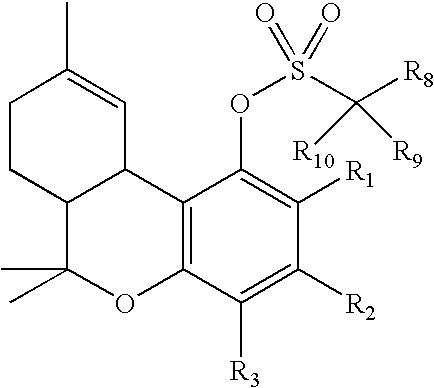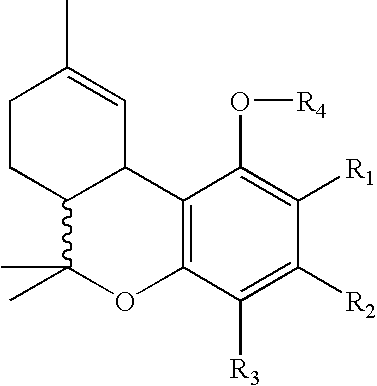Process for production of delta-9-tetrahydrocannabinol
a technology of delta-9 and tetrahydrocannabinol, which is applied in the field of process for preparing ()transdelta9tetrahydrocannabinol, can solve the problems of difficult or impossible separation and purification, no general method by which to favor delta-9-unsaturation kinetics, and poor selectivity. , the effect of poor control
- Summary
- Abstract
- Description
- Claims
- Application Information
AI Technical Summary
Benefits of technology
Problems solved by technology
Method used
Image
Examples
example 1
Preparation of Ethyl Cannabidiolate by Condensation of Ethyl Olivetolate with Menthadienol
[0097]Ethyl olivetolate (25 g, 99 mmol) was dissolved in dichloromethane (250 mL) and MgSO4 (25 g, 1 wt) and Sc(OTf)3 (4.88 g, 9.9 mmol, 10 mol %) were added sequentially. A solution of menthadienol (24.5 g, 161 mmol, 1.6 equiv, assuming purity of 100% but really approximately 80-85% AUC by GC) in dichloromethane (125 mL) was added over 1.5 h using a dropping funnel. The reaction was monitored by HPLC analysis and after approximately 3 h the reaction was filtered through celite, the solids washed with dichloromethane (125 mL), and the combined organics were evaporated under reduced pressure. The residue was dissolved in heptane and applied to 5 wt silica, then eluted with heptane (1×500 mL), 10% dichloromethane / heptane (6×500 mL), 15% dichloromethane / heptane (2×500 mL) and 20% dichloromethane / heptane (2×500 mL). Fractions containing ethyl cannabidiolate were combined and concentrated to give th...
example 2
Preparation of Cannabidiol
[0098]The ethyl cannabidiolate from Example 1 (31.3 g, 81 mmol) was dissolved in MeOH (10 vol, 310 mL) and degassed with argon. Separately, a solution of NaOH (64.8 g, 1.62 mol, 20 equiv) in deionized water (10 vol, 310 mL) was prepared and degassed with argon. The organic solution was added to the aqueous solution under a strict argon atmosphere, then the mixture heated to reflux and held there for 3.5 h, then cooled to room temperature. HPLC analysis indicated completion of reaction. The reaction mixture was quenched with aqueous citric acid (129.6 g citric acid, 8.3 equiv, as a 30% solution in water). The addition was exothermic. Heptane (310 mL, 10 vol) was added to the mixture and the product extracted into the heptane phase. A second extraction using heptane (150 mL, ca. 5 vol) was then performed and HPLC analysis of the aqueous fractions indicated the absence of the cannabidiol. The combined organics were dried by azeotropic distillation of the water...
example 3
Preparation of trans-delta-9-THC
[0099]The cannabidiol from Example 2 (18.5 g, 58.8 mmol) was dissolved in dichloromethane (324 mL, 17.5 vol) and heated to 25° C. Triisobutylaluminum (5.9 mL of 1 M solution in hexane, 10 mol % catalyst) was then added via syringe and the reaction stirred at 20-25° C. for approx 20 h. After this time, HPLC analysis of the reaction mixture showed consumption of the cannabidiol and 94.8% trans-delta-9-THC. The reaction was quenched with water (1.6 mL, 15 equiv. based on moles of catalyst) and stirred for 1 h. After filtration through celite, the solvent was switched to toluene and the reaction mixture azeotroped to remove any remaining water. The solution of product in toluene (total volume ca. 92 mL) was used directly in the subsequent step.
PUM
| Property | Measurement | Unit |
|---|---|---|
| temperature | aaaaa | aaaaa |
| temperature | aaaaa | aaaaa |
| temperature | aaaaa | aaaaa |
Abstract
Description
Claims
Application Information
 Login to View More
Login to View More - R&D
- Intellectual Property
- Life Sciences
- Materials
- Tech Scout
- Unparalleled Data Quality
- Higher Quality Content
- 60% Fewer Hallucinations
Browse by: Latest US Patents, China's latest patents, Technical Efficacy Thesaurus, Application Domain, Technology Topic, Popular Technical Reports.
© 2025 PatSnap. All rights reserved.Legal|Privacy policy|Modern Slavery Act Transparency Statement|Sitemap|About US| Contact US: help@patsnap.com



